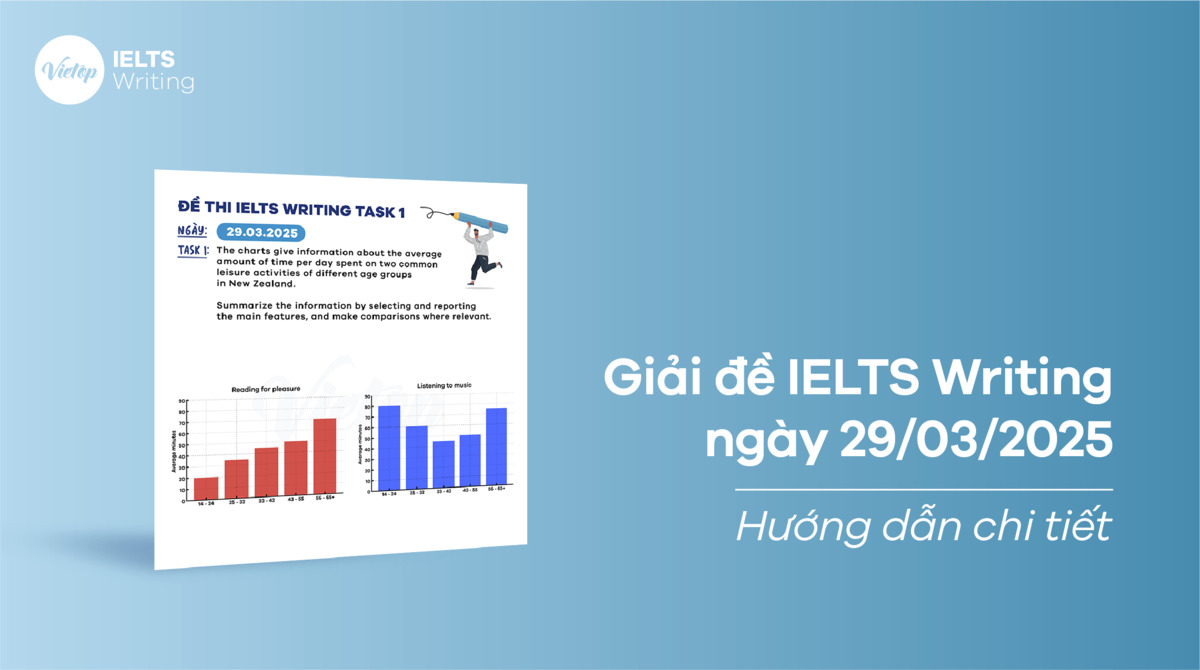Trong kỳ thi IELTS ngày 25/01/2025, đề thi Writing Task 2 là một đề bài có dạng Two-part question, và có chủ đề về gia đình mà mình nghĩ là nhiều bạn cũng đang gặp phải. Theo mình, đây là một đề bài khá dễ viết.
Cụ thể, đề bài IELTS Writing Task 2 như sau: Nowadays in many countries young people don’t communicate with older people as much as they used to. Why is this happening? How could this situation be improved?
Trong bài viết này, hãy cùng mình khám phá cách xử lý dạng bài này một cách hiệu quả: Từ phân tích đề, lập dàn ý chi tiết, đến việc áp dụng chiến lược viết hiệu quả để bài viết của bạn được hay, rõ ràng hơn, thuyết phục hơn, và giúp bạn đạt được band điểm mong ước.
Cùng mình học bài thôi!
1. IELTS Writing Task 2
| Nowadays in many countries young people don’t communicate with older people as much as they used to. Why is this happening? How could this situation be improved? |
| (Hiện nay, ở nhiều nước, người trẻ không giao tiếp nhiều với người lớn bằng trước kia. Tại sao việc này lại xảy ra? Tình huống này có thể được cải thiện như thế nào?) |
1.1. Bước 1: Phân tích đề
- Dạng bài: Two – part question
- Từ khóa: Young people, communicate, older people, as much as they used to, why is this happening, how, this situation, be improved
- Phân tích yêu cầu: Đề bài cho bạn một thực trạng, là người trẻ không còn nói chuyện với người lớn (có thể là ba mẹ, ông bà, hay họ hàng có vai vế/ tuổi tác lớn hơn) nhiều như trước đây. Sau đó, đề bài hỏi bạn lý do tại sao lại có thực trạng này, và cách để cải thiện tình huống này như thế nào.
=> Mình sẽ dành mỗi đoạn thân bài cho một câu hỏi của đề:
- Với câu hỏi “Why is this happening”, mình sẽ đưa ra lý do rằng khoảng cách thế hệ trong thời đại này là quá lớn (quan điểm sống của hai thế hệ khác nhau rõ rệt, và người trẻ lẫn người lớn đều không thực sự sẵn sàng lắng nghe và thấu hiểu lẫn nhau).
- Với câu hỏi “How could this situation be improved”, mình sẽ đưa ra cách cải thiện rằng: Cả hai phía đều nên sẵn sàng lắng nghe lẫn nhau mà không phán xét một cách vội vàng, và bỏ qua cái tôi của bản thân để ưu tiên mối quan hệ.
Hướng dẫn cách viết các dạng bài khác:
- Cách làm dạng bài IELTS Writing Task 2 – Agree or Disagree chi tiết
- Cách viết dạng Positive & Negative – IELTS Writing Task 2
- Cách viết Advantage and Disadvantage trong IELTS Writing Task 2
1.2. Bước 2: Lập dàn ý
| Introduction: Viết lại đề bài theo cách khác, sau đó đưa ra quan điểm cá nhân. | |
| Body paragraph 1: Reason for the communication gap – Point: The main reason for the gap is the substantial difference in viewpoints between generations. – Explanation: Older people hold traditional values, while younger people embrace modern ideologies influenced by globalization and technology. – Example: Differences in opinions on social issues (e.g., gender roles, career choices, lifestyle preferences) often lead to disagreements. – Link: Since both sides tend to dismiss each other’s opinions instead of engaging in discussion, meaningful conversations become rare. | |
| Body paragraph 2: A way to improve the situation – Point: The solution lies in open-mindedness, empathy, and prioritizing relationships over personal pride. – Explanation: Active listening and withholding judgment are key to meaningful conversations. – Example: In families, parents and children should listen to each other instead of defending their own views. Shared experiences, like family gatherings, can also help. – Link: By letting go of ego and focusing on emotional connections, young and old individuals can rebuild communication. | |
| Conclusion: Viết lại mở bài theo cách khác, nhắc lại quan điểm cá nhân. Tóm tắt các main idea đã viết trong các đoạn thân bài. |
1.3. Bước 3: Bài mẫu
1.3.1. Bài mẫu band 5.0+
Nowadays, young people don’t talk to older people as much as before. One big reason is that both generations think very different about life, culture and society, which make it hard for them to understand each other. However, if both side try to listen and not judge, they can improve their relationship.
One reason for this problem is that old and young people have very different opinions. Older people like to keep traditions, while young people prefer modern way of thinking. For example, young people support new ideas about jobs, gender roles and lifestyle, but old people think change is not always good. Because of this, they often argue and don’t want to listen to each other. If both side only focus on their own ideas and not try to understand, they stop talking completely.
To fix this, young and old people should be more open-minded and not think their opinion is always right. One way to do this is by listening carefully instead of trying to win argument. For example, in family, parents and children can sit together and talk without getting angry. Also, doing activities together, like having dinner or family trips, can help them talk naturally. If they focus on their relationship more than their pride, they can have better communication.
In conclusion, young and old people don’t talk much because they have different values and don’t want to listen to each other. But if both side try to understand and not judge, their relationship will get better. If they put family and connection first, they can solve this problem and talk more.
1.3.2. Bài mẫu band 7.5+
In today’s world, intergenerational communication has significantly declined, with young people engaging less frequently with their elders than in the past. This phenomenon primarily stems from the vast differences in perspectives on life, culture, and societal norms between the two generations. However, fostering mutual understanding and open-mindedness can bridge this gap and improve relationships.
A major factor contributing to the communication gap is the substantial disparity in viewpoints between younger and older generations. Older individuals often adhere to traditional values, whereas young people embrace modern ideologies shaped by globalization and technological advancements. For instance, social issues such as gender roles, career choices, and lifestyle preferences are frequently sources of contention, as older generations may perceive change as a threat to stability, while younger individuals view it as progress. As a result, both sides tend to dismiss each other’s opinions rather than engage in meaningful discussions, leading to frustration and avoidance. As neither party is willing to acknowledge the validity of differing perspectives, meaningful conversations become increasingly rare.
To address this issue, both generations must cultivate an attitude of open-mindedness and empathy, prioritizing relationships over personal pride. One effective solution is active listening—engaging in conversations without immediate judgment or the desire to impose one’s own beliefs. For example, in a family setting, if both parents and children strive to understand each other’s viewpoints rather than defending their own, a more harmonious dialogue can be achieved. Moreover, fostering shared experiences, such as family gatherings or intergenerational community events, can create opportunities for organic communication, reducing the likelihood of misunderstandings. By letting go of ego and emphasizing emotional connections, both young and old individuals can rebuild the lost bridge of communication.
In conclusion, the widening communication gap between young and old people is largely driven by differences in values and a lack of willingness to engage in open discussions. However, this situation can be improved if both generations adopt a mindset of understanding and prioritize relationships over personal beliefs. With genuine efforts to listen and em+pathize, intergenerational bonds can be strengthened, ensuring a more cohesive society.
Xem thêm:
- [ACE THE TEST] Giải đề IELTS Writing ngày 18/01/2025
- [ACE THE TEST] Giải đề IELTS Writing ngày 16/01/2025
- [ACE THE TEST] Giải đề IELTS Writing ngày 11/01/2025
1.4. Từ vựng
| Từ vựng | Nghĩa |
| Intergenerational communication /ˌɪntərˌdʒɛnəˈreɪʃənəl kəˌmjuːnɪˈkeɪʃən/ | (noun phrase) giao tiếp giữa các thế hệ E.g. Effective intergenerational communication fosters understanding and respect. (Giao tiếp hiệu quả giữa các thế hệ thúc đẩy sự hiểu biết và tôn trọng lẫn nhau.) |
| Phenomenon /fəˈnɑːmɪnɑːn/ | (noun) hiện tượng E.g. The Northern Lights are a beautiful natural phenomenon. (Cực quang là một hiện tượng thiên nhiên tuyệt đẹp.) |
| Vast differences /væst ˈdɪfrənsɪz/ | (noun phrase) sự khác biệt lớn, khoảng cách lớn E.g. The vast differences in customs between Eastern and Western societies make cultural adaptation challenging. (Sự khác biệt lớn về phong tục giữa xã hội phương Đông và phương Tây khiến việc thích nghi văn hóa trở nên khó khăn.) |
| Mutual understanding /ˈmjuːtʃuəl ˌʌndərˈstændɪŋ/ | (noun phrase) sự thấu hiểu lẫn nhau E.g. Cultural exchange programs promote mutual understanding among students from different countries. (Các chương trình trao đổi văn hóa thúc đẩy sự thấu hiểu lẫn nhau giữa sinh viên đến từ các quốc gia khác nhau.) |
| Open-mindedness /ˌoʊpən ˈmaɪndɪdnəs/ | (noun) sự cởi mở, tư duy rộng mở E.g. Traveling helps develop open-mindedness by exposing individuals to diverse cultures. (Du lịch giúp phát triển tư duy cởi mở bằng cách đưa con người tiếp xúc với nhiều nền văn hóa khác nhau.) |
| Disparity /dɪˈspærɪti/ | (noun) sự chênh lệch, sự khác biệt E.g. There is a significant disparity in wealth distribution between urban and rural areas. (Có một sự chênh lệch đáng kể trong việc phân phối tài sản giữa khu vực thành thị và nông thôn.) |
| Adhere /ədˈhɪr/ | (verb) tuân theo, gắn chặt, dính vào một cái gì đó E.g. If you don’t adhere to the dress code, you may not be allowed into the office. (Nếu bạn không tuân theo quy định về trang phục, bạn có thể không được phép vào văn phòng.) |
| Modern ideologies /ˈmɑː.dɚn ˌaɪ.diˈɑː.lə.dʒiz/ | (noun phrase) các tư tưởng hiện đại, hệ tư tưởng hiện đại E.g.The shift toward corporate social responsibility is driven by modern ideologies emphasizing ethical business practices. (Sự chuyển hướng sang trách nhiệm xã hội doanh nghiệp được thúc đẩy bởi các hệ tư tưởng hiện đại nhấn mạnh vào kinh doanh có đạo đức.) |
| Gender roles /ˈdʒɛndər roʊlz/ | (noun phrase) vai trò giới E.g. Gender roles vary significantly across different cultures and historical periods. (Vai trò giới thay đổi đáng kể giữa các nền văn hóa và thời kỳ lịch sử khác nhau.) |
| Lifestyle preferences /ˈlaɪf.staɪl ˈprɛf.ər.ənsɪz/ | (noun phrase) các lựa chọn phong cách sống, các sở thích lối sống E.g. People’s lifestyle preferences influence their daily habits and long-term goals. (Sở thích lối sống của mỗi người ảnh hưởng đến thói quen hàng ngày và mục tiêu dài hạn của họ.) |
| Contention /kənˈtɛnʃən/ | (noun) sự tranh cãi, bất đồng (trong cuộc tranh luận, cãi vã) (noun) luận điểm, quan điểm (trong lập luận) E.g. The issue of climate change remains a point of contention among policymakers. (Vấn đề biến đổi khí hậu vẫn là một điểm gây tranh cãi giữa các nhà hoạch định chính sách.) |
| Perceive /pərˈsiːv/ | (verb) nhận thức, nhìn nhận, hiểu được E.g. It is important to perceive change as an opportunity rather than a challenge. (Điều quan trọng là nhìn nhận sự thay đổi như một cơ hội hơn là một thách thức.) |
| Meaningful discussions /ˈmiː.nɪŋ.fəl dɪˈskʌʃ.ənz/ | (noun phrase) những cuộc thảo luận ý nghĩa, những cuộc trò chuyện sâu sắc E.g. Engaging in meaningful discussions can strengthen relationships and build trust. (Tham gia vào các cuộc thảo luận ý nghĩa có thể củng cố mối quan hệ và xây dựng sự tin tưởng.) |
| Cultivate /ˈkʌl.tɪ.veɪt/ | (verb) nuôi dưỡng, phát triển (kỹ năng, thái độ, mối quan hệ) E.g. It is important to cultivate a positive mindset in challenging situations. (Việc nuôi dưỡng tư duy tích cực trong những tình huống khó khăn là rất quan trọng.) |
| Personal pride /ˈpɜːrsənəl praɪd/ | (noun phrase) niềm tự hào cá nhân; cái tôi của bản thân E.g. Taking care of one’s appearance is often linked to personal pride. (Việc chăm sóc ngoại hình thường liên quan đến niềm tự hào cá nhân.) |
| Judgment /ˈdʒʌdʒ.mənt/ | (noun) sự phán xét, chỉ trích E.g. Many people fear judgment from society when making unconventional choices. (Nhiều người sợ bị xã hội phán xét khi đưa ra những lựa chọn khác thường.) |
| Impose /ɪmˈpoʊz/ | (verb) áp đặt E.g. Parents should not impose their expectations on their children. (Cha mẹ không nên áp đặt kỳ vọng của mình lên con cái.) |
| Harmonious /hɑːrˈmoʊ.ni.əs/ | (adjective) hài hòa, êm đẹp, hòa hợp E.g. A harmonious society is built on mutual respect and understanding. (Một xã hội hài hòa được xây dựng trên sự tôn trọng và thấu hiểu lẫn nhau.) |
| Intergenerational community events /ˌɪntərˌdʒɛnəˈreɪʃənəl kəˈmjuː.nə.ti ɪˈvɛnts/ | (noun phrase) sự kiện cộng đồng liên thế hệ E.g. Organizing intergenerational community events fosters understanding and respect among different age groups. (Việc tổ chức các sự kiện cộng đồng liên thế hệ thúc đẩy sự thấu hiểu và tôn trọng giữa các nhóm tuổi khác nhau.) |
| Organic communication /ɔːrˈɡænɪk kəˌmjuːnɪˈkeɪʃən/ | (noun phrase) giao tiếp tự nhiên, không gượng ép E.g. Unlike scripted conversations, organic communication flows effortlessly. (Không giống như những cuộc trò chuyện được dàn dựng trước, giao tiếp tự nhiên diễn ra một cách trôi chảy.) |
| Emotional connections /ɪˈmoʊʃənəl kəˈnɛkʃənz/ | (noun phrase) sự kết nối cảm xúc E.g. Emotional connections between family members create a sense of belonging and security. (Sự kết nối cảm xúc giữa các thành viên trong gia đình tạo ra cảm giác gắn kết và an toàn.) |
1.5. Cấu trúc
1.5.1. Câu phức sử dụng “whereas”
| S + V + O + whereas + S’ + V’ + O’ |
E.g. Older individuals often adhere to traditional values, whereas young people embrace modern ideologies shaped by globalization and technological advancements.
(Những người lớn tuổi thường tuân theo các giá trị truyền thống, trong khi giới trẻ tiếp nhận các tư tưởng hiện đại được định hình bởi toàn cầu hóa và những tiến bộ công nghệ.)
- Mệnh đề chính: “Older individuals often adhere to traditional values”
- Mệnh đề phụ: “young people embrace modern ideologies shaped by globalization and technological advancements”
- Từ nối “whereas” giúp đưa ra sự tương phản giữa mệnh đề chính và mệnh đề phụ, thể hiện được mối quan hệ đối lập giữa 2 nhóm đối tượng (older individuals và young people)
1.5.2. Câu phức với cụm đồng vị ngữ
| S + [appositive] + V + O + [participle phrase] |
E.g. Fostering shared experiences, such as family gatherings or intergenerational community events, can create opportunities for organic communication, reducing the likelihood of misunderstandings.
(Việc thúc đẩy các trải nghiệm chung, chẳng hạn như những buổi sum họp gia đình hoặc các sự kiện cộng đồng liên thế hệ, có thể tạo ra cơ hội cho giao tiếp tự nhiên, giảm khả năng xảy ra hiểu lầm.)
- Mệnh đề chính: “Fostering shared experiences, such as family gatherings or intergenerational community events, can create opportunities for organic communication”
- Cụm phân từ: “reducing the likelihood of misunderstandings” đóng vai trò làm cụm trạng từ, giải thích thêm cho kết quả của “fostering shared experiences”
- Cụm đồng vị ngữ “such as family gatherings or intergenerational community events” có vai trò bổ ngữ cho cụm danh từ “shared experiences” ở chủ ngữ, giúp minh họa rõ ràng hơn cho những “shared experiences”.
2. Kết luận
Chuẩn bị tốt cho IELTS Writing không chỉ giúp bạn tự tin hơn mà còn nâng cao cơ hội đạt điểm số như mong muốn. Hy vọng qua bài viết này, bạn đã bỏ túi được những chiến lược hữu ích để cải thiện kỹ năng viết và áp dụng hiệu quả vào bài thi.
Nếu bạn có bất kỳ thắc mắc nào về bài giải đề IELTS Writing Task 2 ngày 25/01/2025, hãy để lại bình luận bên dưới nhé! Đội ngũ Vietop English luôn sẵn sàng lắng nghe, giải đáp và đồng hành cùng bạn trên hành trình chinh phục band điểm mong muốn!
Chúc các bạn ôn tập tốt và đạt được kết quả cao trong kỳ thi IELTS sắp tới!


![[ACE THE TEST] Giải đề IELTS Writing ngày 07/04/2025](https://vietop.edu.vn/wp-content/uploads/2025/04/giai-de-ielts-writing-ngay-07-04-2025.png)

![[ACE THE TEST] Giải đề IELTS Writing ngày 15/03/2025](https://vietop.edu.vn/wp-content/uploads/2025/03/giai-de-ielts-writing-ngay-15-03-2025.jpg)
![[ACE THE TEST] Giải đề IELTS Writing ngày 22/03/2025](https://vietop.edu.vn/wp-content/uploads/2025/03/giai-de-ielts-writing-ngay-22-03-2025.jpg)
![[ACE THE TEST] Giải đề IELTS Writing ngày 08/03/2025](https://vietop.edu.vn/wp-content/uploads/2025/03/giai-de-ielts-writing-ngay-08-03-2025.jpg)
![[ACE THE TEST] Giải đề IELTS Writing ngày 06/03/2025](https://vietop.edu.vn/wp-content/uploads/2025/03/giai-de-ielts-writing-ngay-06-03-2025.jpg)
![[ACE THE TEST] Giải đề IELTS Writing ngày 22/02/2025](https://vietop.edu.vn/wp-content/uploads/2025/02/giai-de-ielts-writing-ngay-22-02-2025.jpg)
